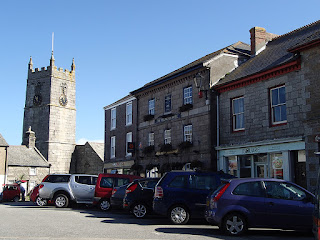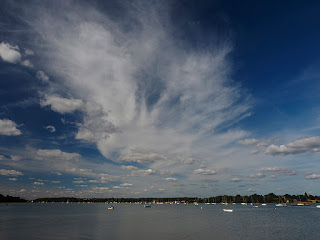1st Oct
It was a tedious trip to Bristol, getting stuck in traffic jams and cruising the M4. There was a little excitement getting to our hotel due to masses of people and cars, and a recalcitrant sat nav trying to send us down pedestrian only streets. Don't you love hearing "you have arrived at your destination" when it's blatantly untrue - we could see the street just couldn't turn into it. Once we eventually made it, we couldn't face attempting to venture out again to find the car parking building, so paid the exorbitant hotel valet parking fee.
After a couple of hours to rest, Jeremy's ex-colleague Michael came and collected us. I'm glad we didn't try to drive ourselves, as the streets around his place are so narrow you have to back out again. It was a very pleasant evening with a lovely meal - bizarrely, Sharon and I have never met before, even though Jeremy and Michael had worked together for 22 years.
2nd Oct
 |
| Bristol - credit:S |
We started the day watching the Malaysian F1 Grand Prix, an unexpected bonus as we thought we'd miss them all while away, and then we still had enough time to visit the SS Great Britain before having to return the rental car to Heathrow.
It was a beautiful crisp autumn morning and many people were making the most of the Bristol city waterfront, around the canal off the River Avon. The area has been extensively developed over the last few years, mainly with apartments, cafes and bars but with much of the history preserved, such as the steam crane, the railway tracks and steam train.
 |
| SS Great Britain - credit:J |
The SS Great Britain was built in 1843 and was the first large steam driven iron ship and the first luxury cruise ship, travelling the trans-Atlantic route to New York. It was designed by Brunel who was definitely an engineering genius, and is now being recognised as such. Unfortunately, the SS GB had a chequered career: it ran aground in 1846 and it was 11 months before it was refloated, was then sold and turned into a ship to transport immigrants to Australia before being converted to a sailing ship in 1881 for hauling cargo to San Francisco. It was badly damaged in a storm, and diverted to the Faulklands, where it was sold essentially as a warehouse to store coal and wool. It was eventually sunk in shallow water, where it sat for 30 years being used as a picnic and fishing platform. In 1970, she was rescued and returned to the dry dock Bristol where she was built, restored and opened to the public in 2005.
 |
| SS Great Britain - credit: S |
It's a great exhibition with galley, engine room, dining saloons and cabins set up for all 3 classes - travelling steerage out to Australia would have been very grim. Even the first class cabins had bunks way too small for Jeremy. The dry dock itself is interesting too, especially with its glass ceiling cover in water to give the illusion of the ship floating.
The run through to London was straightforward and we arrived at our Airbnb place just before 6pm. We ate at a new pizza restaurant in Stoke Newington High Street - this part of Stokie has somewhat improved since our last visit in 2014.
 |
| SS Great Britain, propeller and rudder - credit:J |
3rd Oct
I had a quiet day at home, catching up on washing and other chores. This included a trip to the laundrette to use the dryer. I love walking around this part of Stokie (strictly speaking, I think it's Stamford Hill), with its Haredim Jews (and their bizarre hats, some like giant furry doughnuts), Turks, West Indians and typical London geezers. I even saw "wooden top" bobbies (I thought they got rid of those helmets years ago!). I met up with Ross for a walk in the afternoon - he works from home, and tries to take a break each day. Another beautiful autumn day, and Clissold Park was lovely in the sunshine. Different sort of people at this end of Stokie - more gentrified, mums with pushchairs, cafes rather than laundrettes.
Meanwhile Jeremy had a busy day wandering the streets of central London, hopping into bits of various museums, looking at Samurai armour and swords among other things.
Dinner was at the Jolly Butcher pub and fittingly we had a platter of German sausages.
4th Oct
 |
| Worthing from the pier - credit:J |
Today we went to Worthing on the south coast to visit our friend Joss who now lives there. We caught the train from Victoria but stupidly didn't book the tickets online in advance so paid a premium - all up, it was about £50 each return, including coming home via Brighton. Rail travel isn't cheap, but it's worse if you don't book ahead.
Worthing is your classic British seaside town, with terrace houses along the waterfront, a shingle beach with wooden groynes to stop erosion and the mandatory pier. The town itself has a nice feel - a much better place for Joss to base herself and Danny (her young son) than London.
 |
| Worthing Terraces with NZ native plants - credit:S |
It was very windy on the waterfront and pier, much like a Wellington southerly, but lunch in the Art Deco styled pier restaurant gave us great views out to sea and along the coast to Brighton. It was great to catch up with Joss and to see her so much happier.
 |
| Royal Pavillion - credit: S |
We went home via Brighton so I could go to the Royal Pavillion. I'd seen the banqueting hall on TV and loved its dragons, so wanted to see them in person. It's a strange place, built by extending a farmhouse in the late 18th century, remodelled/extended using cheap materials (fake stone) in first half of the 19th century, then abandoned by the royals (leaked too much and Queen Vic didn't like Brighton), used as a hospital in WWI and II until eventually restored for the public - although the restoration is pretty much a rebuild and still on going.
 |
| Dragon - credit: victoriana.com |
Most of what you see, such as carpets and wallpapers, are modern copies. The dragon chandelier however is original and didn't disappoint. No photos allowed inside, so again I've stolen one!
As you can't go to Brighton without seeing the pier, we walked down to the seaside where the sun was starting to get dimmer in spite of still being a long way above the horizon - a combination of sea mist and pollution, so a real smog. I don't really relate to the whole pier thing, but they are truly a British institution and Brighton's is quite an impressive example. Like Worthing, the beach is steep and pebbled. In the distance was the new tourist attraction that opened in August, the i360 tower, apparently the tallest moving observation tower. It's basically a thick tall pole with an impaled flying saucer that travels slowly up and down the pole. We saw it as it was reaching the bottom, but gave up waiting for it to go up again.
The train trip back gave tantalising glimpses of countryside in the setting sun. Like the hedgerows of Cornwall, the train cuttings hide the views most of the time. We arrived home in the dark, having had an M&S snack for tea while waiting for the bus.
 |
| Borough Market - credit: J |
5th Oct
We had a slow start to the day today. Jeremy went off to Ross' barber in Church St for a very efficient hair cut while I did yet another load of washing. We decided to have lunch at Borough Market. Although this is a bit of a tourist trap, there is some great food for sale. Jeremy's pork pie vendor was still there, but this time his pie didn't seem so great - there is no beating the real thing from Dickinson & Morris in Melton Mowbray. I chose a hot chicken and tarragon pie, which was very nice. As kids, we were always allowed a pie and doughnut for lunch on our birthdays, so a doughnut was needed to follow the pie (even though it wasn't my birthday as J so rightly pointed out). We'd had amazing doughnuts here last trip, and sure enough, they were still available, stuffed with amazing vanilla custard. We also bought something for consumption later: cured meats (including seaweed and cider salami) and blue cheese soaked in dessert wine.
Having satisfied our stomachs, it was time for some culture. We had never been to the Tate Britain before, only the Tate Modern. The main exhibition is a walk through the history of British Art from 1545 to the present. They also have the largest collection of Turners and a small collection of Constables, including one of Fen Lane that we walked down only 2 weeks ago.
Back to Ross and Mad's for the evening, with a small, healthy (but still delicious) home cooked meal - such a pleasant change.
 |
| Turing's Bombe - credit:S |
6th Oct
Bletchley Park (BP) has long been on our agenda of places to visit, even before the movie The Imitation Game, but somehow have never found the time - until today. It's a 45 minute train trip from Euston, and an easy day trip, especially as BP is only a short walk from the station. The weather was still holding well, albeit with a cold breeze.
For those that don't know, BP was the base for the WWII codebreakers who deciphered German messages encrypted by the Enigma (and later the Lorenz) machines. The process was partly automated by Alan Turing's machine called the Bombe. I didn't realise there were quite a lot of these in existence by the end of the war, all demolished in the name of secrecy, however a group of enthusiasts undertook a rebuild, so we were able to see a replica in action. Quite impressive. Must have been a tedious job "programming" and babysitting them each day, a job undertaken by shifts of WRENs. I have determined that I do not have a mind suited to cracking codes, based on my appalling efforts on the interactive displays. Given that much of the codebreaking still required the human brain to make intuitive leaps, I greatly admire what they achieved.
 |
| Colossus - credit:S |
We also went to the National Museum of Computing, which was disappointing, although nostalgic (punch card machines, HP calculators, Commodore Pets etc). The displays weren't well put together, and much of the ancillary info wasn't helpful. However, the rebuilt Colossus was the main reason for going there, and that was quite a sight - the first ever electronic computer made with 1500 valves. There were 10 of these built, again in WWII for decryption purposes, but they were also destroyed and their existence remained secret for many years. Consequently the Americans thought their ENIAC computer was the first. Having also seen that at the Smithsonian, I have definitely seen the first, whichever it is!
We finished the day with cod and chips at what was the local chippie, but has had an upgrade to a rather nice cafe - same people, same food (but with healthy salads added) and somewhere to sit.



















































